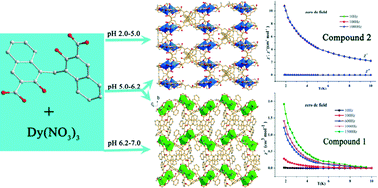Highly pH-dependent synthesis of two novel three-dimensional dysprosium complexes with interesting magnetic and luminescence properties†
Abstract
Two novel Dy-based MOFs, namely, {[Dy2(PA)3(H2O)3(DMF)]·(DMF)2·(H2O)}n (1) and [Dy2(PA)3(H2O)2(DMF)2]·(DMF)3·(H2O)}n (2) (H2PA = pamoic acid), were solvothermally synthesized from the reaction of Dy(NO3)3 and H2PA at different pH values. Interestingly, both complexes can be obtained simultaneously within the pH range of 5.0–6.2, while higher pH values (6.2–7.0) promote the formation of compound 1 and lower pH values (2.0–5.0) tend to produce pure complex 2. Single-crystal X-ray diffraction studies indicate that 1 and 2 are both three-dimensional frameworks composed of dinuclear Dy(III) subunits featuring pcu networks with the point symbol of {412·63}. Significantly, their slight structure difference results in these two compounds showing completely different magnetic properties. Variable temperature magnetization measurements (χMT–T) demonstrate ferromagnetic interactions in compound 1, while possible antiferromagnetic interactions were observed in compound 2. Alternating current (ac) susceptibility measurements indicate that both the in-phase (χ′) and out-of-phase (χ′′) components showed frequency dependence in compound 1, suggesting that there is a slow relaxation behavior of the magnetization, which is typical of single-molecule magnets (SMMs), while no out-of-phase ac signal was noticed for 2. Furthermore, both 1 and 2 exhibit the characteristic luminescence of Dy3+ upon excitation at 365 nm, but with different intensities. The reasons for such magnetic and luminescence differences are discussed in detail.


 Please wait while we load your content...
Please wait while we load your content...